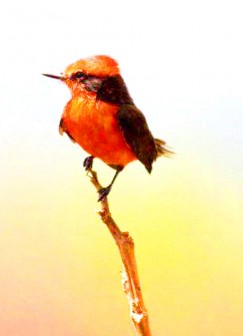The Vermilion Flycatcher (Pyrocephalus rubinus) is tiny but aptly named and can be seen sitting and marking its territory in open savannah areas of the North Rupununi. These birds are often seen in the grounds at the Rock View Lodge in the North Rupununi.
The male and female are markedly dimorphic (different markings); the male is bright vermilion on the crown, nape, breast and belly. It has a black mask and blackish brown on the back, wings and tail. In contrast, the female has a pale red or peachy coloured belly with a grey-streaked breast and the crown, back, wings and tail are a greyish brown. She also carries a greyish white strip on the face.
Vermilion Flycatchers can be found from the southwest United States, through Central America to northwest and central South America. They prefer habitats that are wide open and can be found in savannahs, scrublands, farmlands, desert and riparian woodlands. The species is diurnal and spends very little time on the ground.
They are territorial and mark their territory by perching and flying the perimeter of their space, returning to perch on the same branches every time. Within their territory, they sally forth from branches to catch their next meal in midflight. Like other flycatchers, Vermilion Flycatchers feed on insects and they particularly like flies, grasshoppers and beetles.

During the breeding season, March-May, the males can be seen displaying potential nesting sites and calling the females to take a look. The selected female is the one who makes the final choice on the nest site. The pair can be seen displaying together after the selection. Once the female starts building the nest, made of twigs, stems and roots, and lined with hair, the male leaves her to her work. He will feed her while she incubates the eggs. Vermilion Flycatchers are monogamous. The female lays 2-3 eggs which can range in colour from white, cream, tan or brown. The eggs are incubated for two weeks and all the eggs hatch within 24 hrs. Both parents take care of the chicks which fledge within 15 days. They usually feed them butterflies and moths including the larvae.
The species has been listed as least concern by the IUNC though the populations in the north are facing threats from lost of habitat due to urbanisation and the use of pesticides.
Rain forests are rich in biodiversity and are home to many different plants and animals as well as indigenous communities. Humans, even those who don’t live in the rain forest, rely on it for resources such as building materials (wood and lianas), medicine and fruits. Rain forests also provide essential environmental services for life on earth; they create soil as well as prevent soil erosion, produce oxygen though photosynthesis, maintain clean water systems, and are a key defence against climate change.
The Iwokrama Rain Forest is 371,000 hectares, located in the heart of Guyana. Our mission is to develop strategies for conservation and sustainable development for local people in Guyana and the world at large. We are involved in timber, tourism and training. Come and visit us in the rain forest or at http://www.iwokrama.org.





